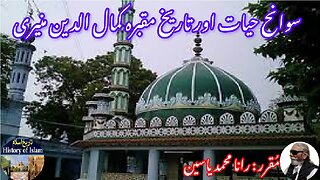Premium Only Content

History of Tomb of Hazrat Noah (AS) | تاریخ مقبرہ حضرت نوح علیہ السلام
@islamichistory813 #TombOfHazratNoah #ReligiousHistory #CulturalSignificance
History of Tomb of Hazrat Noah (AS)
Asslamoalaikum sisters brothers friends and elders, we are describing in this islamic informative of holiest sites video provides a comprehensive overview of the history and significance of the Tomb (Maqbara) of Hazrat Noah (AS). It delves into the historical and religious importance of this sacred site, shedding light on its origins and the stories surrounding it. Viewers will gain a deeper understanding of the cultural and spiritual significance of the Tomb (Maqbara) of Hazrat Noah (AS) through this informative presentation.
The Tomb of Noah (Nuh) refers to a building that is regarded as the burial of prophet Noah. There are several locations contested as the burials of prophet Nuh, at least five such sites are known to exist.
This video attempts to enlist the sites, believed or reported as the tomb of prophet Noah, but none of these can be verified with archaeological record. Prophet Noah is believed to have lived in 2006 AM (Anno Mundi).
The Tomb of Noah in Cizre, Turkey is situated in the courtyard of Nebi Nuh Mosque. To the east is Cudi Da?, identified as Mt. Ararat in some traditions. The tradition from Cizre claims that it was the original burial place of Noah and his family. However, the tradition can not be confirmed. Cizre citizen ?bnülesin Firuzabadi, Evliya Çelebi, Ebubekir Helevi and Babili Berasus had written that this structure, one of the oldest tombs of Anatolia, has belonged to Noah. There is a wooden sarcophagus over the tomb. The tomb and the mosque there over have been restored by Noah Nebi Building and Surviving Association.
According to Armenian tradition, Noah's Tomb (Nuh pey??mb?r türb?si) is located in the town of Nakhchivan. The 19th century Russian and European sources such as the Brockhaus and Efron Encyclopedic Dictionary and John Foster Fraser noted that the local Armenians considered it a holy place. The tomb consists of remains of the lower storey of a former temple, with a ladder leading to a burial vault. The chamber contains a stone column which is rumoured to contain relics of Noah. Architecture of the construction is dated from the 8th century CE.
Noah's tomb, 'the tomb of the honored old navigator' is on the outskirts of a new town called Kerak. It is located in the west of the city of Karak in the south of Jordan, and it is a small-sized building (57 square meters) of stone and clay in green color topped by a dome in the middle of the city's Karak cemetery, which was named "Noah's Tomb", and the construction date back to the Mamluk era, which was destroyed more than once It was completely restored last time by the Ottoman Empire in the year 1920. This shrine is not a shrine, as scholars of history confirm that he did not reside in that region, but they confirm its passage there.
According to tradition by al-Mukaddasi, the tomb in Karak Nuh, existed since the tenth century. The stone tomb measures around 31.9m long, 2.7 m wide and 0.98 m high and is covered in a raggedy green cloth. According to Sir Richard Burton the size of the monument possibly derives from tales of ancient giants, but is more realistically suggested to be a section of an ancient aqueduct that has been converted to serve as a shrine. There is also a courtyard outside the building with a prayer niche.
According to Shi'a tradition, buried next to Ali within the mosque of Imam Ali in Najaf Iraq, are the remains of prophets Adam and Noah. The tradition is not archaeologically substantiated, but is related to Ja'far as-S?diq.
Another grave in the Indian city of Ayodha is attributed to prophet Noah. Also known as the Navgazi Mazar (also spelled as Naughazi) it is situated behind the Ayodhya police station. This tomb is considered to be the replica or spatial manifestation of the one in the town of Najaf in Iraq, which was narrated in details by the Moroccan Arab traveller Ibn Battuta (1304-1369 CE) in his travel accounts. This is also described in the British reports and the Gazetteer of Oudh (1877-88 CE), however the Ain-i-Akbari, a 16th century text (cf. Jarrett 1948), does not mention this tomb/grave.
So friends, tomorow inshahAllah same time, will be described, The History of Islamic Holiest site Shrine Hazrat Imam Ali (AS), Allah Hafiz
================================
-
 6:34
6:34
ISLAMIC HISTORY
1 day agoKamaluddin Yahya Maneri & his shrine کمال الدین یحیی منیری کی سوانح عمری اور ان کے مزار کی تاریخ
4 -
 UPCOMING
UPCOMING
The Mike Schwartz Show
1 hour agoTHE MIKE SCHWARTZ SHOW with DR. MICHAEL J SCHWARTZ
49 -
 1:05:07
1:05:07
TheCrucible
2 hours agoThe Extravaganza! EP: 09 with Guest Host: Jay Dyer (6/23/25)
66.1K14 -
 DVR
DVR
Kim Iversen
2 hours agoIsrael Increasingly Isolated — Trump’s "Truce" With Iran Raises New Questions
24.5K42 -
 16:30
16:30
Clownfish TV
2 hours agoStar Wars Just Put Rey in a Corner...
4.95K2 -
 UPCOMING
UPCOMING
Quite Frankly
5 hours ago"Grace's Trial, Bombs Away in Iran, Open Lines" ft. Scott Schara 6/23/25
1.59K -
 LIVE
LIVE
LFA TV
23 hours agoLFA TV ALL DAY STREAM - MONDAY 6/23/25
1,225 watching -
 LIVE
LIVE
RalliedLIVE
1 hour ago $0.19 earnedMonday WZ - Specialist Addict Gets Wins
149 watching -
 38:24
38:24
Kimberly Guilfoyle
3 hours agoDecision Points: Latest News with Roger Stone | Ep232
82.3K28 -
 41:29
41:29
Redacted News
2 hours agoThis pilot whistleblower exposed a child trafficking ring and what happened next is STUNNING
48K40